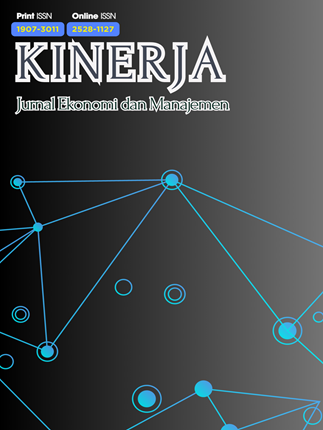Pemasaran kewirausahaan dan kapabilitas operasi untuk meningkatkan keunggulan bersaing lpd
DOI:
https://doi.org/10.30872/jkin.v18i3.9957Keywords:
Pemasaran kewirausahaan, kapabilitas operasi, keunggulan bersaing, lpdAbstract
Penelitian ini bertujuan menggali kaitan kosep pemasaran kewirausahaan, kapabilitas operasi untuk meningkatkan keunggulan bersaing LPD di kabupaten Buleleng. Model penelitian dikembangkan dengan menggabungkan dua fungsi perusahaan yaitu pemasaran dan operasi untuk meningkatkan keunggulan bersaing lembaga perkreditan desa (LPD) di Kabupaten Buleleng. Sampel penelitian ini merupakan lembaga perkreditan desa di kabupaten buleleng yang masuk kategori sehat sejumlah 80 LPD, yang tersebar di sembilan kecamatan di Kabupaten Buleleng. Pendekatan yang digunakan yaitu pendekatan kuantitatif. Sumber data penelitian ini merupakan data primer yang diperoleh melalui penyebaran kuesioner kepada pimpinan LPD di Kabupaten Buleleng. Teknik analisis data dengan metode analisis SEM berbasis GSCA. Pemasaran kewirausahaan berpengaruh langsung terhadap kapabilitas operasi. Pemasaran kewirausahaan tidak terbukti berpengaruh langsung ke keunggulan bersaing, Kapabilitas operasi terbukti memediasi hubungan antara pemasaran kewirausahaan dengan keunggulan bersaing LPD di kabupaten Buleleng. Temuan penelitian ini secara keseluruhan menunjukkan bahwa kombinasi pemasaran kewirausahaan dan kapabilitas operasi merupakan instrumen strategis yang mendasari LPD di kabupaten Buleleng dalam mempertahankan atau meningkatkan keunggulan bersaingnya.
References
Andersén, J. (2010). Resourcebased competitiveness: managerial implications of the resourcebased view. Strategic Direction, 26(5), 3–5. https://doi.org/10.1108/02580541011035375
Asad, M. (2012). Porter Five Forces vs Resource Based View - A Comparison. SSRN Electronic Journal, 1–12. https://doi.org/10.2139/ssrn.1986725
Barrales-Molina, V., Montes, F. J. L., & Gutierrez-Gutierrez, L. J. (2015). Dynamic capabilities, human resources and operating routines A new product development approach. Industrial Management and Data Systems, 115(8), 1388–1411. https://doi.org/10.1108/IMDS-02-2015-0058
Boström, P., & Krol, F. A. (2018). Evaluation of important operations capabilities for competitive manufacturing in a high- cost environment Master Thesis in Business Administration. May.
Fillis, I. (2010). The art of the entrepreneurial marketer. In Journal of Research in Marketing and Entrepreneurship (Vol. 12, Issue 2). https://doi.org/10.1108/14715201011090576
Gilmore, A. (2011). Entrepreneurial and SME marketing. Journal of Research in Marketing and Entrepreneurship, 13(2), 137–145. https://doi.org/10.1108/14715201111176426
Gonzalez-Padron, T., Hult, G. T. M., & Calantone, R. (2008). Exploiting innovative opportunities in global purchasing: An assessment of ethical climate and relationship performance. Industrial Marketing Management, 37(1), 69–82. https://doi.org/10.1016/j.indmarman.2007.06.013
Hacioglu, G., Eren, S. S., Eren, M. S., & Celikkan, H. (2012). The Effect of Entrepreneurial Marketing on Firms’ Innovative Performance in Turkish SMEs. Procedia - Social and Behavioral Sciences, 58, 871–878. https://doi.org/10.1016/j.sbspro.2012.09.1065
Hidayatullah, S., Firdiansjah, A., Patalo, R. G., & Waris, A. (2019). The Effect Of Entrepreneurial Marketing And Competitive Advantage On Marketing Performance. 8(10), 1297–1301.
Hills, G. E., & Hultman, C. M. (2011). Academic Roots: The Past and Present of Entrepreneurial Marketing. Journal of Small Business and Entrepreneurship, 24(1), 1–10. https://doi.org/10.1080/08276331.2011.10593521
Kaleka, A. (2012). Studying resource and capability effects on export venture performance. Journal of World Business, 47(1), 93–105. https://doi.org/10.1016/j.jwb.2010.10.024
Kamboj, S., Goyal, P., & Rahman, Z. (2015). A Resource-Based View on Marketing Capability, Operations Capability and Financial Performance: An Empirical Examination of Mediating Role. Procedia - Social and Behavioral Sciences, 189, 406–415. https://doi.org/10.1016/j.sbspro.2015.03.201
Koufteros, X. A., Vonderembse, M. A., & Doll, W. J. (2002). Integrated product development practices and competitive capabilities: The effects of uncertainty, equivocality, and platform strategy. Journal of Operations Management, 20(4), 331–355. https://doi.org/10.1016/S0272-6963(02)00018-9
Kraus, S., Harms, R., & Fink, M. (2010). Entrepreneurial marketing: Moving beyond marketing in new ventures. International Journal of Entrepreneurship and Innovation Management, 11(1), 19–34. https://doi.org/10.1504/IJEIM.2010.029766
Makmur, N., & Chairunisa, Y. (2018). The Effect of Entrepreneurial Marketing on Competitive Advantage : Small Culinary Souvenir Industry in Jalan Mojopahit Medan , Indonesia. January. https://doi.org/10.2991/ebic-17.2018.90
Miocevic, D., & Morgan, R. E. (2015). Article information :
Mort, G. S., Weerawardena, J., & Liesch, P. (2012). Advancing entrepreneurial marketing: Evidence from born global firms. European Journal of Marketing, 46(3–4), 542–561. https://doi.org/10.1108/03090561211202602
O’Leary-Kelly, S. W., & Flores, B. E. (2002). The integration of manufacturing and marketing/sales decisions: Impact on organizational performance. Journal of Operations Management, 20(3), 221–240. https://doi.org/10.1016/S0272-6963(02)00005-0
Ramanathan, R., Ramanathan, U., & Zhang, Y. (2016). Linking operations, marketing and environmental capabilities and diversification to hotel performance: A data envelopment analysis approach. International Journal of Production Economics, 176, 111–122. https://doi.org/10.1016/j.ijpe.2016.03.010
Sansone, C., Hilletofth, P., & Eriksson, D. (2018). Critical operations capabilities in a high cost environment: A multiple case study. In IOP Conference Series: Materials Science and Engineering (Vol. 337, Issue 1). https://doi.org/10.1088/1757-899X/337/1/012065
Shee, H. K., & Foley, P. (2008). The Relationship between Operations Capability and Firm Competitiveness. International Journal, September.
Stephen, O. U., Ireneus, N., & Moses, O. C. (2019). ENTREPRENEURIAL MARKETING PRACTICES AND COMPETITIVE. 7(3), 1–30.
Thomas, L. C., Painbéni, S., & Barton, H. (2013). Entrepreneurial marketing within the French wine industry. International Journal of Entrepreneurial Behaviour and Research, 19(2), 238–260. https://doi.org/10.1108/13552551311310392
Winter, S. G. (2003). Understanding dynamic capabilities. Strategic Management Journal, 24(10 SPEC ISS.), 991–995. https://doi.org/10.1002/smj.318


